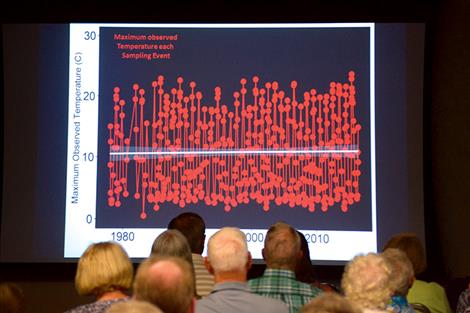State of the Lake: Looking good, but vigilance needed
Hey savvy news reader! Thanks for choosing local.
You are now reading
1 of 3 free articles.
News from Flathead Lakers
YELLOW BAY — Flathead Lake Biological Station Lake Ecologist Dr. Shawn Devlin presented a snapshot of the lake’s condition at the Flathead Lakers 2016 annual meeting.
Devlin, who is completing a post-doctorate research and teaching position at the Biological Station this summer, will soon join its faculty as a Research Assistant Professor. He is in charge of the station’s water quality monitoring program and has been using the station’s long-term data record to model its physical and biological characteristics.
Devlin said that long-term data from the mid-lake monitoring station indicate that the lake is not warming up, although it may be a different story in sheltered bays.
The amount of the nutrient phosphorus in the lake has been stable since 1990. Nitrogen, however, is a different story, as it has “drastically increased since 1996 and is still increasing at all depths.” Changing that trend is a difficult challenge, though, as the sources of atmospheric deposition of nitrogen come from outside the watershed. Periphyton, the algae attached to rocks along the shore, is increasing, which may be caused by problems with septic systems. Lake clarity, measured by secchi disk depth, is increasing, although Bio Station researchers can’t say exactly why.
Mysis shrimp are a strong regulator of the lake system. Their numbers have been oscillating a great deal throughout the past 12 years, and currently increasing rapidly. Mysis are starting to inhabit shallower waters, including in the photic zone, the surface waters that light penetrates, “where they are not supposed to be,” Devlin said.
Recent changes in the size distribution of Mysis appear to indicate that they are now breeding twice a year. This has been seen in other lakes, but only those that have higher productivity than Flathead Lake. In years with higher Mysis populations, there is a lot of chlorophyll present, few zooplankton, and low primary productivity — a measure of the rate of algal growth.
The conservation and restoration work done by the Flathead Lakers and its partners along the river is “fundamental to keeping Flathead Lake blue,” Devlin said, explaining that the Biological Station’s monitoring program is vital for keeping “a finger on the pulse of the lake,” so changes and problems can be discovered quickly. A bonus is that it helps researchers better understand the lake’s ecology.
The threat of new aquatic invasive species introductions and the potential for a catastrophic event like an oil train spill in the Middle Fork of the Flathead River are Devlin’s top concerns.
“Even though we have an amazing template to work with, we could still mess it up,” he said.
















